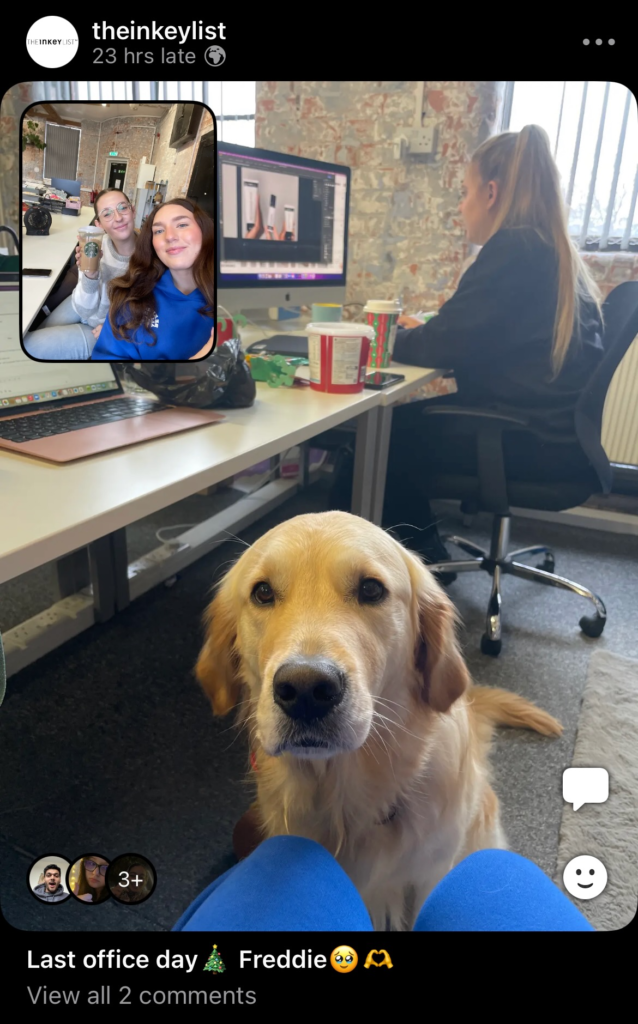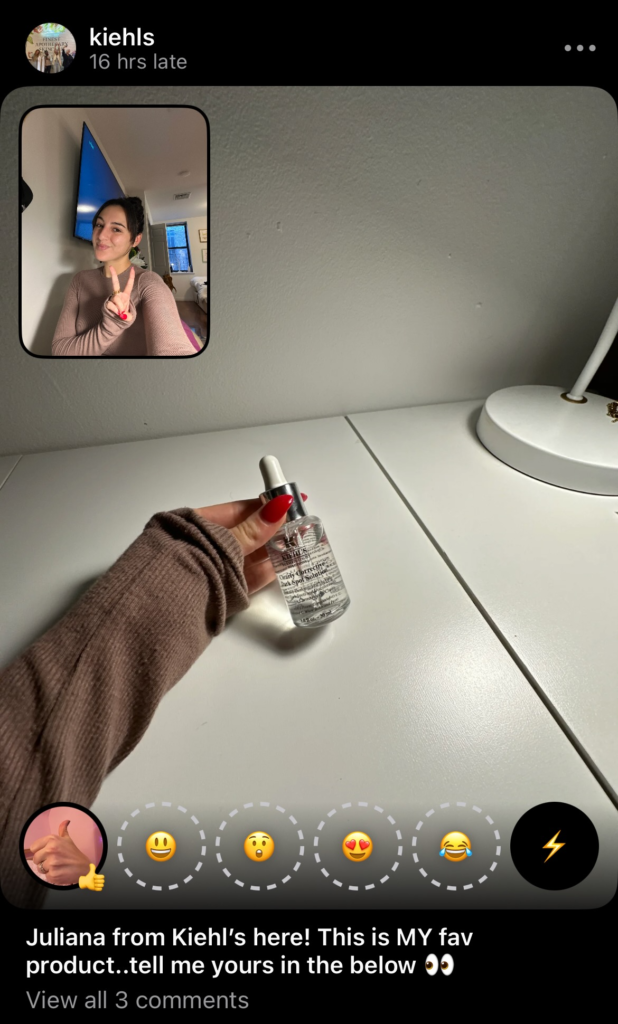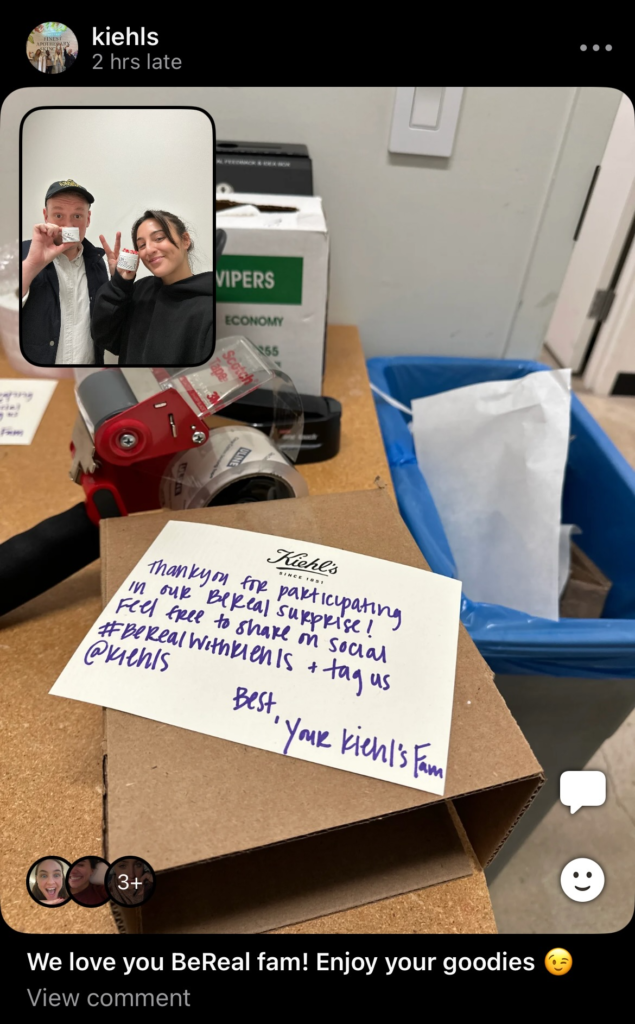Beauty, Branding, and Navigating the Crowdculture Boundaries of BeReal
Aidan Moir / University of Toronto Scarborough
In August 2022, Women’s Wear Daily published an article with the headline, “Are Brands Ready to ‘BeReal’?” [1] The fashion-focused trade journal reported on the beauty industry’s growing presence on BeReal. e.l.f. Cosmetics was the first beauty brand to launch on the platform; Ulta Beauty, Superdrug, Sephora, Urban Decay Cosmetics, Saie, The INKEY List, The Ordinary, Rare Beauty, Kiehl’s, and Glow Recipe have all established BeReal accounts within the past year. What makes BeReal a lucrative platform for beauty brands? How does BeReal’s affordances enable beauty brands to extend the reach of their communities in a manner ‘authentic’ to their neoliberal ethos in promotional culture?
Described by Women’s Wear Daily as “the latest social media app that’s all about authenticity,” BeReal sends users a push notification to capture a photograph within a two-minute window (late posts are still accepted). BeReal users must post a photo to view other content, which combined with its minimalist interface, reflects founders Alexis Barreyat and Kevin Perreau’s intention to design a platform for those disenchanted with the curated and seemingly inauthentic material inundating other social media networks. Since its 2020 launch, BeReal’s popularity has grown substantially with over 73.5 million active users as of January 2023. The platform experienced significant growth in 2022, with reports that the majority of BeReal’s 67 million downloads occurred during this timeframe.[2]
What distinguishes BeReal from other social media platforms is the total lack of advertising support and promoted content. Unable to market products in a method now commonplace on other platforms, brands must create content in a style that appeals to BeReal’s platform vernacular.[3] While TikTok’s algorithm, sponsored content, and native advertising help brands reach viewers, BeReal users must actively seek out brands on the platform and wait for their friend request to be approved. Representing a shift in platform labour, the beauty brands on BeReal are dependent upon the agency of users to search for their profile. Although brands like e.l.f. Cosmetics and Rare Beauty encourage TikTok viewers to engage with them on BeReal, the limited affordances of BeReal reinforce the need for brands to maintain presence on the central social media platforms in the digital creative economy.
The popularity of beauty brands on BeReal is situated within larger cultural formations of brand communities and self-care culture on social media. BeReal provides companies with an opportunity to extend the reach of their brand community, a conceptual framework analyzing how the social relationships that develop around a company, product, or service prioritize socially constructed values of care and responsibility.[4] For Douglas Holt, brands become iconic when they embrace the narratives and ethos of their community, a strategy he refers to as cultural branding. While many brands have struggled to adapt to the demands of social media marketing, Holt argues successful brands leverage crowdculture, a phenomenon of social innovation where “digital crowds serve as very effective and prolific innovators of culture.”[5]
Crowdculture shapes the cultural formations and aesthetics enabling beauty culture to proliferate into a lucrative entity on social media. The “#beauty” has almost 150 billion views on TikTok and the industry recorded over $22 billion in revenue for 2021 – an impressive number considering the continued impact of the COVID-19 pandemic. Analyzing the discursive construction of the “#ThatGirl” aesthetic on TikTok – referring to videos promoting makeup tips and multi-step skincare regiments – Kaitlin Marisol Sweeney-Romero argues that this aspirational aesthetic “idealizes thin, white girls and women as a universally desirable beauty ideal that all should aspire to.”[6] Numerous “#ThatGirl” videos feature products from beauty brands that have benefitted tremendously from their visibility on TikTok, such as Rare Beauty and Glow Recipe. Recent headlines from publications including Teen Vogue (“20 TikTok-Viral Beauty Products That Were All Over Our FYPs in 2022”) and Elle (“28 Viral Beauty Products You Need to Buy ASAP”) underscore how lucrative TikTok’s discursive aesthetics and virality can be for brand visibility in a highly competitive marketplace.[7] The viral visibility of e.l.f. Cosmetics on TikTok – their products are frequently praised by content creators as “dupes” for more expensive brands – has led the company to rise six spots to become the second favourite beauty company for teens.[8] It is no coincidence that many of the beauty brands associated with TikTok virality, like Rare Beauty and e.l.f. Cosmetics, have migrated to BeReal to extend their circulatory power.
The brands that have received attention for their BeReal presence promote themselves as ethical and sustainable options for younger, more socially conscious communities. Glow Recipe’s website welcomes users into “our community that believe in inclusivity, individuality & sustainability.”[9] Founded by Selena Gomez, Rare Beauty’s brand vision is to dismantle hegemonic beauty standards, “nurture a caring, respectful community,” and “create a safe, welcoming space in beauty – and beyond – that supports mental well-being across age, gender identity, sexual orientation, race, cultural background, physical or mental ability, and perspective.”[10] The rhetorical emphasis that these brands place upon community is one of the main draws of BeReal due to its emphasis on spontaneous, unedited content. In a feature with Glossy, Rare Beauty’s CEO Ashley Murphy emphasizes that “the premise of BeReal aligns with our brand ethos; we aim to break down the unrealistic standards of perfection, and we saw this platform as an opportunity to bring this to life while also meeting our community.”[11] Reproducing similar rhetoric, e.l.f. Cosmetics’ Chief Brand Officer Laurie Lim reflected on the company’s BeReal success with Women’s Wear Daily. Admitting they had no specific platform marketing strategy, Lim emphasized their BeReal popularity was about “put[ting] something out there and just really waiting to see how the community responded to us.”[12] The vague rhetoric of community becomes an empty signifier for brands to allow their identity on social media platforms like BeReal to be shaped by Holt’s notion of crowdculture. The popularity of Rare Beauty, Glow Recipe, and e.l.f. Cosmetics in social media beauty trends like “#ThatGirl” – which often reproduce hegemonic discursive formations of white femininity – requires a continued critical evaluation of the discursive boundaries of community on BeReal.
Although many of the brands who have incorporated BeReal into their promotional strategy prioritize messages of authenticity and inclusivity, the affordances of the platform minimize participation in these brand communities. The limits on the number of followers an account can collect imposed by BeReal potentially restricts the ability for users to engage with various brand communities on the platform. After announcing their BeReal debut on August 23, 2022, Rare Beauty responded just over a week later with a post announcing they had already reached their follower limit. Using TikTok’s greenscreen function to highlight a screenshot of their profile on the BeReal’s interface to the memetic audio, “What on earth is going on in the house of commons,” Rare Beauty lightly joked in the post caption, “I’m just trying to have fun with my besties 😔 Let them in @bereal.”[13] As of January 2023, Rare Beauty’s BeReal account is still at the limit of allowed followers. Combined with the transitory ephemeral nature of BeReal – posts disappear after 24 hours – the platform’s affordances pose significant challenges to develop the inclusive communities imagined by corporate rhetoric.
For many beauty labels, BeReal currently acts as a platform to extend the reach of their brand communities. Tactics like contests, sneak peeks, promotional giveaways, and discount codes circulated through BeReal posts encourage users to gravitate to the brand’s main social media pages and purchase products. A BeReal post from the Kiehl’s account depicts a picture of Juliana (presumably an employee) holding her favourite product, with a caption asking users to share their preferences in the comments. Selected users were asked to share their contact details on Instagram to receive a free package of Kiehl’s products. BeReal content by e.l.f Cosmetics, Glow Recipe, and The INKEY List provide members of their brand community with a glimpse into the workdays of their employees; e.l.f. Cosmetics has commemorated their interns in BeReals, while The INKEY List has showcased their London corporate headquarters visited by employee pets. The behind-the-scenes nature of these BeReal posts enable users to vicariously experience the inner-workings and mundane everyday realities of these brands in a visual rhetoric that is in line with the platform’s vernacular.
While BeReal content for companies like Rare Beauty and Glow Recipe may be designed to further circulate their corporate ethos of challenging hegemonic beauty standards for the betterment of their community, their goal, like all the beauty brands, is to sell products and generate revenue. Regardless of a brand’s commitment to sustainability and community, it is important to acknowledge the industry’s environmental impact, as Refinery21 did in an April 2022 commentary on the relationship between virality, social media advertising, and the beauty industry. In addition to the extraction of limited raw resources, the environmental impact of shipping emissions, and roughly 120 billion units of cosmetic packaging generated each year, almost 40% of newly bought makeup and skincare products are discarded as trash.[14] For beauty brands, the social sharing on BeReal is not a permanent strategy but a lucrative cross-platform tool to interpolate users as authentic consuming citizens with their larger brand communities that simultaneously reflects, normalizes, and conceals hegemonic neoliberal cultural formations within consumer capitalism.
Image Credits:
- Author’s screenshot of Urban Decay Cosmetics BeReal post depicting a Sephora shopping bag, BeReal, January 8, 2023
- Rare Beauty (@rarebeauty). “I’m just trying to have fun with my besties 😔 Let them in @bereal #whatonearthisgoingon #rarebeauty #bereal #greenscreen.” TikTok, August 31, 2022, https://www.tiktok.com/@rarebeauty/video/7138159201322388782?lang=en.
- Author’s screenshot of The INKEY List employee pets, BeReal, December 22, 2022
- Author’s screenshot of Kiehl’s with Juliana’s favourite products, BeReal, December 13, 2022
- Author’s screenshot of Kiehl’s Free Goodies, BeReal, December 15, 2022
References:
- Rhonda Richford, “Are Brands Ready to ‘BeReal’?” Women’s Wear Daily, last modified August 30, 2022. https://wwd.com/business-news/technology/are-brands-ready-to-bereal-1235301069/. [↩]
- David Curry, “BeReal Revenue and Usage Statistics,” Business of Apps, last modified January 9, 2023, https://www.businessofapps.com/data/bereal-statistics/. [↩]
- Martin Gibbs, James Meese, Michael Arnold, Bjorn Nansen, and Marcus Carter, “#Funeral and Instagram: Death, Social Media, and Platform Vernacular,” Information, Communication & Society 18, no. 3 (2015): 257-258. [↩]
- Albert M. Muniz and Thomas O’Guinn, “Brand Community,” Journal of Consumer Research 27, no. 4 (2001): 412-432. [↩]
- Douglas Holt, “Branding in the Age of Social Media,” Harvard Business Review 94, no. 3 (2016): 42. [↩]
- Katlin Marisol Sweeney-Romero, “Wellness TikTok: Morning Routines, Eating Well, and Getting Ready to Be “That Girl,” in TikTok Cultures in the United States, edited by Trevor Boffone (New York: Routledge, 2022), p. 113. [↩]
- Kara Nesvig, “20 TikTok-Viral Beauty Products That Were All Over Our FYPs in 2022,” Teen Vogue, last modified December 23, 2022, https://www.teenvogue.com/story/20-tiktok-viral-beauty-products-that-were-all-over-our-fyps-in-2022 and Tatjana Freund, “28 Viral Beauty Products You Need to Buy ASAP,” Elle, last modified December 15, 2022, https://www.elle.com/beauty/g41954425/viral-tiktok-beauty-gifts/. [↩]
- Jessica Harrington, “TikTok Has Changed the Game for Beauty Brands, but How – and Why?” POPSUGAR, last modified June 25, 2021, https://www.popsugar.com.au/beauty/tiktok-impact-beauty-industry-48392650. [↩]
- “Welcome to Glow Recipe,” Glow Recipe, https://www.glowrecipe.com/pages/about-us. [↩]
- “About Us,” Rare Beauty, https://rarebeauty.com/pages/about. [↩]
- Liz Flora, “BeReal Is Bringing on Bigger Beauty Brands,” Glossy, last modified September 6, 2022, https://www.glossy.co/beauty/bereal-is-bringing-on-bigger-beauty-brands/. [↩]
- Rhonda Richford, “Are Brands Ready to ‘BeReal’?” Women’s Wear Daily, last modified August 30, 2022. https://wwd.com/business-news/technology/are-brands-ready-to-bereal-1235301069/. [↩]
- Rare Beauty (@rarebeauty), “I’m just trying to have fun with my besties 😔 Let them in @bereal #whatonearthisgoingon #rarebeauty #bereal #greenscreen.” TikTok, August 31, 2022, https://www.tiktok.com/@rarebeauty/video/7138159201322388782?lang=en. [↩]
- Jacqueline Kilikita, “The Difficult Truth About TikTok’s Beauty Obsession,” Refinery21, last modified April 19, 2022, https://www.refinery29.com/en-us/beauty-tiktok-over-consumption. [↩]




Nice blog